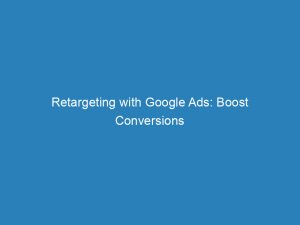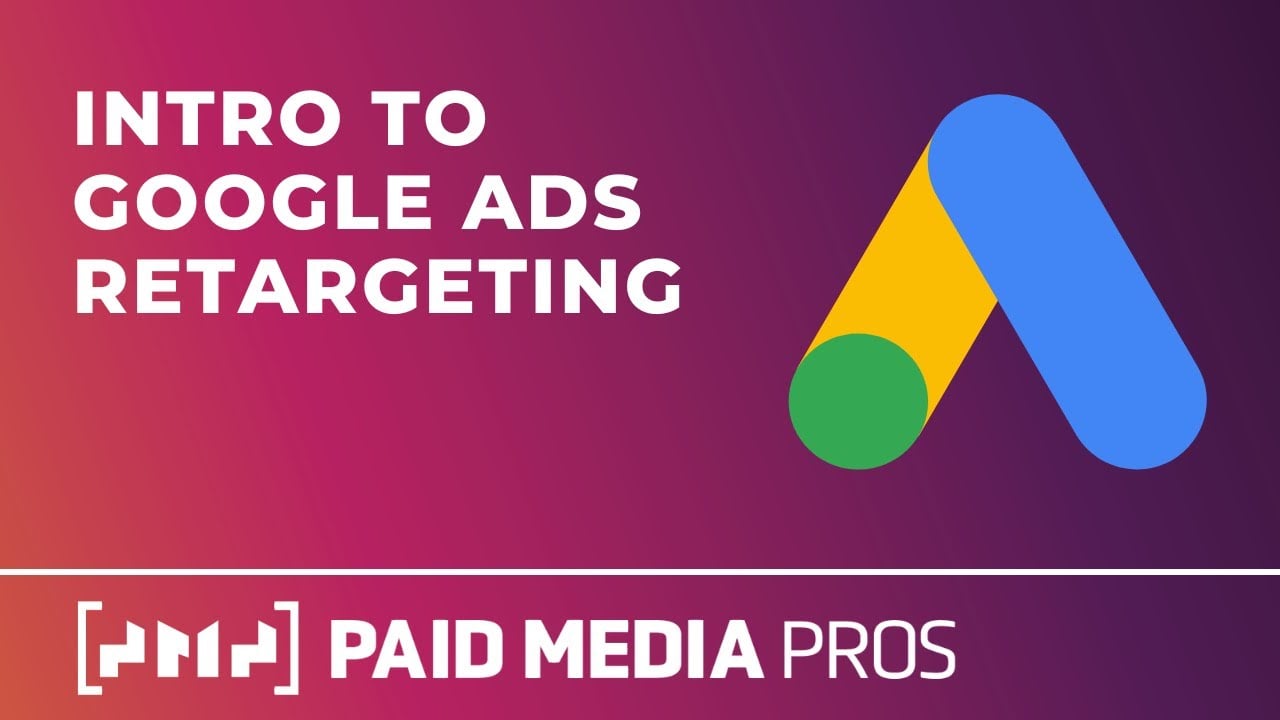In today’s digital landscape, capturing and retaining the attention of potential customers can be a challenging endeavor. With countless websites vying for their attention, how can you ensure that your business stands out from the crowd and recaptures lost visitors?
Enter GoogleAdsretargeting. By strategically using tagging and setting up specific criteria, this powerful platform allows you to target prospective customers who have shown previous interest in your website.
From customizing retargeting lists to tailoring messages through dynamic retargeting, GoogleAds offers a wealth of options to help drive conversions. Join us as we explore the world of retargeting with Google Ads and unlock the potential of bringing lost prospects back to your website.
Table of Contents
- retargeting with google ads
- Retargeting With Google Ads: Driving Prospective Customers Back To The Website
- Recapturing The 98%: Importance Of Retargeting In Google Ads
- Step 1: Tagging For Google Ads Retargeting
- Creating Audiences For Effective Retargeting In Google Ads
- Options For Retargeting In Google Ads: Search, Display, Dynamic, Video
- Monitoring And Optimization: Key To Effective Retargeting Campaigns
- Targeting Specific Criteria With Google Ads Retargeting
- Customizing Retargeting Lists Beyond Website Visitors
- Extending Membership Duration For Higher Conversion Rates
retargeting with google ads
Retargeting with Google Ads is a powerful strategy that helps businesses drive prospective customers back to their website. It addresses the challenge of recapturing the 98% of website visitors who leave without making a purchase.
The first step in setting up Google Ads retargeting is tagging, which involves placing a tracking code on the website to collect user data. With this data, audiences can be created based on specific criteria such as website visitors, custom combinations, and similar audiences.
Google Ads offers various options for retargeting, including search retargeting, display retargeting, dynamic retargeting, and video remarketing. Effective monitoring and optimization of retargeting campaigns are crucial to maximize their effectiveness and return on investment.
Additionally, retargeting with Google Ads allows for targeting specific date ranges, list sizes, and visits to specific URLs. Customization of retargeting lists beyond simple website retargeting is also possible, such as targeting visitors to specific pages during certain dates or visitors to blog posts.
Excluding people who have visited certain pages, like a checkout page, can be an effective strategy. Extending the membership duration of retargeting lists can lead to more conversions over time.
Furthermore, Google Ads retargeting can be utilized for mobile app users and YouTube channel viewers and members. Dynamic retargeting enables tailored messages and offers based on users’ interests.
Additionally, Google Ads Retargeting with Customer Match functionality is similar to Facebook’s lookalike audience targeting. To enhance effectiveness, it is suggested to create new ads based on each retargeting list and segmented offers.
Overall, retargeting with Google Ads provides a powerful tool for businesses to bring back potential customers and increase conversions.
Key Points:
- Google Ads retargeting helps drive prospective customers back to a business’s website.
- Tagging is the first step in setting up Google Ads retargeting and involves placing a tracking code on the website.
- Various options are available for retargeting with Google Ads, including search retargeting, display retargeting, dynamic retargeting, and video remarketing.
- Monitoring and optimizing retargeting campaigns is important for maximizing effectiveness and return on investment.
- Google Ads retargeting allows for customization of targeting specific date ranges, list sizes, and visits to specific URLs.
- Retargeting can be utilized for mobile app users, YouTube channel viewers, and members, and offers personalized messages and offers based on users’ interests.
Sources
https://adespresso.com/blog/google-ads-retargeting-guide/
https://support.google.com/google-ads/answer/7688468?hl=en
https://support.google.com/google-ads/answer/3124536?hl=en
https://www.reliablesoft.net/google-ads-remarketing/
Check this out:
💡 Pro Tips:
1. Consider using Google Ads Customer Match for retargeting, which allows you to target users who have provided their contact information.
2. Utilize dynamic retargeting to deliver personalized messages and offers to users based on their past interactions with your website.
3. Experiment with different ad creatives and segmented offers for each retargeting list to increase effectiveness and engagement.
4. Take advantage of Google Ads retargeting for mobile app users and YouTube channel viewers to maximize your reach and conversions.
5. Extend the membership duration of your retargeting lists to give users more opportunities to convert and increase your chances of generating sales.
Retargeting With Google Ads: Driving Prospective Customers Back To The Website
Retargeting is a crucial strategy for driving prospective customers back to your website. It aims to recapture the attention of those 98% of visitors who leave without making a purchase.
By strategically targeting these individuals with personalized ads, you have the ability to reignite their interest and guide them through the conversion funnel.
Google Ads retargeting offers businesses a powerful tool to reconnect with their audience. Through ad placements on various websites and platforms within the Google network, businesses can effectively reach out to individuals who have previously shown an interest in their products or services.
This allows for a more targeted and personalized approach to engage potential customers.
Recapturing The 98%: Importance Of Retargeting In Google Ads
The vast majority of website visitors leave without completing a purchase or conversion. This can be frustrating for businesses that invest time and resources into attracting visitors to their site.
However, retargeting with Google Ads presents an opportunity to bring those lost prospects back into the fold.
By strategically displaying ads to individuals who have previously interacted with your website, you increase the likelihood of a conversion. It serves as a reminder to prospective customers about your brand and the products or services you offer.
Through consistent exposure to your ads, these prospects are more likely to return to your website and complete a desired action.
Step 1: Tagging For Google Ads Retargeting
The first step in setting up Google Ads retargeting is tagging. This involves placing a small snippet of code, known as a pixel, on your website.
The pixel collects data about the actions users take on your site, such as the pages they visit or the products they view.
Tagging is crucial as it enables Google to track and identify these users, allowing you to create targeted retargeting campaigns. The pixel also helps provide valuable insights into user behavior, which can inform your overall marketing strategy and campaign optimization.
Creating Audiences For Effective Retargeting In Google Ads
Once you have implemented the necessary tags, you can start creating audiences for effective retargeting in Google Ads. Audiences can be defined based on specific criteria, including website visitors, custom combinations, and similar audiences.
Website visitor audiences allow you to target individuals who have visited your website or specific pages within a certain time frame. Custom combinations enable you to refine your audience based on a combination of actions taken on your site, such as specific pages visited or products added to cart.
Similar audiences help expand your reach by targeting individuals who share similar characteristics to your existing customer base.
Options For Retargeting In Google Ads: Search, Display, Dynamic, Video
Google Ads provides a range of options for retargeting, catering to different ad formats and platforms. These options include search retargeting, display retargeting, dynamic retargeting, and video remarketing.
Search retargeting allows you to display ads to individuals who have previously performed relevant searches on Google. This ensures that your ads are shown to users actively seeking products or services similar to what you offer.
Display retargeting involves showing ads on websites within the Google Display Network. This allows for broader exposure and can be an effective way to reengage with potential customers who have already visited your site.
Dynamic retargeting takes personalization to the next level by tailoring ads based on the specific products or services individuals have shown interest in. This creates a highly relevant and engaging ad experience, increasing the chances of conversion.
Video remarketing allows you to target individuals who have previously interacted with your YouTube channel or watched your videos. This is an effective way to reconnect with users who have shown an interest in your brand through video content.
Monitoring And Optimization: Key To Effective Retargeting Campaigns
Proper monitoring and optimization of retargeting campaigns are essential for achieving optimal effectiveness and return on investment (ROI). Regularly reviewing campaign performance, including click-through rates and conversion rates, will provide insights into the effectiveness of your ads.
By identifying underperforming ads or audiences, you can make informed adjustments to improve campaign results. Testing different ad creatives, copy variations, and audience segments can help refine targeting and maximize engagement.
A/B testing is a valuable technique in retargeting campaigns. By creating multiple versions of ads or landing pages and testing them against each other, you can identify the most effective elements and optimize your campaign accordingly.
Targeting Specific Criteria With Google Ads Retargeting
Beyond the general retargeting options, Google Ads allows for more targeted criteria to refine your retargeting efforts. You can target specific date ranges, list sizes, and even visitors to specific URLs.
By targeting specific date ranges, you can focus on recent visitors who are more likely to convert. This ensures that your ads are seen by individuals who have recently engaged with your website or brand.
Customizing retargeting lists beyond website visitors can further enhance your targeting capabilities. For example, you can create lists based on individuals who have taken specific actions on your site, such as adding items to their cart or signing up for a newsletter.
This level of customization allows for more tailored ad experiences and increases the chances of conversion.
Customizing Retargeting Lists Beyond Website Visitors
Retargeting lists can be customized beyond simple website retargeting. By leveraging specific visitor behavior, you can create highly targeted campaigns based on visitors to specific pages during certain dates or visitors to blog posts.
For example, if you have different product categories or service offerings on your website, you can create retargeting campaigns specific to those pages. This ensures that users see relevant ads related to their initial interest.
Furthermore, you can exclude people who have visited certain pages, such as a checkout page, to focus on individuals who are still early in the conversion process.
Extending Membership Duration For Higher Conversion Rates
Extending the membership duration of retargeting lists can lead to higher conversion rates. By default, retargeting lists have a limited duration, typically 30 days.
However, extending this duration allows you to continue targeting individuals who may need more time before making a purchase decision.
By staying top-of-mind and consistently reminding prospects of your products or services, you increase the chances of conversion. This is particularly effective for businesses with longer sales cycles or high-value purchases that require more consideration.
In conclusion, retargeting with Google Ads is a powerful strategy to drive prospective customers back to your website. By effectively tagging your website, creating targeted audiences, and utilizing various retargeting options, you can maximize engagement and conversion rates.
The key to success lies in proper monitoring, optimization, and customization of your retargeting campaigns. With careful planning and strategic implementation, retargeting can significantly boost your conversions and engagement.












